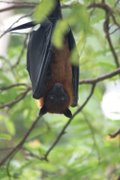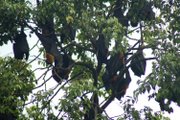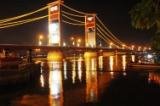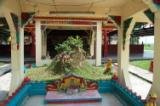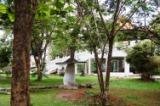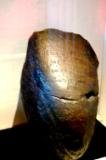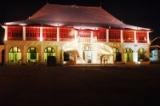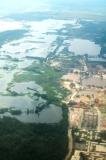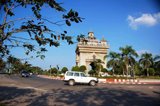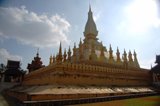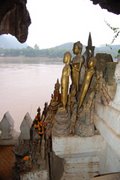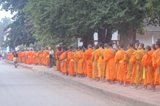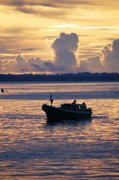Historians have hardly reached a consensus about it when in 1924 somebody discovered that there was indeed a kingdom called Sri Vijaya in this part of the world. The point of argument being where was in fact its capital. Whether it was Jambi, Palembang or even Chaiya? The first two locations are in south Sumatra while one is in South Thailand. Now it is generally accepted that the earlier two are almost certainly more correct. Two of the three capitals, at least.
Sri Vijaya at the height of its glory stretched from parts of Indochina down to what is now Indonesia and west to the shores of Africa and along the way encompassing present day Sri Lanka. If Palembang can lay claim to being the seat of power for a number of years, it cannot, however, claim to be the original capital. A stone inscription of Kedudukan Bukit (dated AD 683) proved that one Hyung Dapunta Jayanaga from Minanga captured Mukha Upang (Palembang). Minanga, located farther south on the east coast of Sumatra was referred to by I-tsing, a Chinese scholar as Shih-Li-Fo-Shih.
I-tsing stopped by there for four months to do his matriculation in Sanskrit under the tutelage of Buddhist monks before proceeding to Moloyu and on to Nalanda (India) for further studies. On his return after graduation, he again stayed in Shih-Li-Fo-Shih. He was to return there several times. Shih-Li-Fo-Shih at that time had very close relations with China. To confuse things further, Minanga subsequently disappeared completely from the face of southern Sumatra (sounds like it was the first case of tsunami to me). This first phase of Sri Vijaya lasted less than 100 years.
In came Sri Vijaya number two started by the Sailendras of Central Jawa, the first king being Balaputra Dewa. His capital city, however, was Swarnabhumi or golden land, referred to in Chinese chronicles as San-Fo-Tsi. This dynasty was to last from 860 to 1156. It was later defeated by Jawa and the old capital was relegated in status to old port. It was referred to by another Chinese scholar, Ma Huan as Chiu Chiang (old port). He put on record that Chiu Chiang or San-Fo-Tsi was also called Po-Lin-Fong. During this second period, San-Fo-Tsi also constructed a pagoda in Ligor (present day Nakhon Sri Thammarat in South Thailand).
Sri Vijaya III or San-Fo-Tsi II came into being from 1156 to 1373 under its first king Pangeran Suryanarana with its capital in Jambi north of Po-Lin-Fong. There were 15 states under the kingdom. Again according to Chinese chronicles (what would we do without them) among the states apart from Po-Lin-Fong were Pong Fong (Pahang), Tong Ya Nong (Terengganu), Ling Ya Si Kia (Langkasuka), Si-Lan (Ceylon) and Kui-Lan-Tan (Kelantan). Following that Sri Vijaya broke up into three kingdoms – Palembang, Minangkabau and Melayu.
At least while it lasted Sri Vijaya was huge by any standards, a commonwealth of sorts, rivalled by only China at that time and Alexander the Great’s territories at one time. Co-incidentally some of the Indonesian kings had claimed to be from Alexander’s lineage. His Indonesian name of course was Iskandar Zulkarnain. Others would claim to be descendents of Vishnu like Balaputra Dewa, who founded Sri Vijaya II.
It is little wonder that Chaiya (now most well-known for its salted eggs) in the province of Suratthani in South Thailand had also been put forward belatedly as one of the possibilities as its capital. But if it was, then one could certainly assume that its commerce would be a little more diverse than salted eggs.
Still there is no denying that Sri Vijaya have had quite a bit of influence in the region with statues and ruins from that period found littered all over Thailand and Indochina. The Thais have a name for that old kingdom – Sri Vichai (pronounced Sivichai). This would probably explain why traditional women dressing in Suratthani and Nakhon Sri Thammarat, for example, do not differ very much from those of the Indonesians. In addition, the name Vichai or Vichaya in Thai is actually Vijay on the Indian sub-continent and of course Vijaya in Indonesia. And Chaiya of course is Sri Vijaya with the Sri and Vi omitted over time and probably the best claim that it was indeed one of Sri Vijaya’s former capital city.
But Palembang, even if it could not claim to be the only capital of old Sri Vijaya, at least can now claim to be Indonesia’s fifth largest city. The name Palembang came about because of the fact that the place was water-logged and full of swamps. It still is a bit water-logged but now full of houses of different shapes, sizes and makes.
Seen from the air as the plane descended to touch down at Sultan Badaruddin II International Airport during my visit there, it seemed to me that the city of Palembang looked like a whole lot of water surrounded by patches of land. It certainly gave the impression that if the captain got his calculations terribly wrong and we were to miss the airport, we would eventually found use for a life jacket and whistle to attract attention.
The airport was impressive enough, not in the way KLIA or Suwanabhumi International Airport in Thailand are, of course. Getting out of the airport to the hotel in the city I was more impressed by the bottleneck jam. And that was just the queue to pay the parking fees. After that, it seemed like a breeze as every driver seemed to have their own idea about what constituted good driving and speed limits, so before long we were already at our hotel. I was to be more impressed by the fact that mini-buses seem to breeze around the city with the conductor’s door open and the conductors (no more than 15 or 16 year-olds) hanging three quarters of the way out soliciting passengers. How they manage to keep themselves from falling off or the doors from slamming into other vehicles or pedestrians is certainly a source of wonder especially at the speed most were going.
After the hotel, it was off for some nasi padang and a tour of the town’s hero’s mausoleum cum memorial. Sadly it did not seem well-kept and about the only name I could relate to was Parameswara’s brother, who was buried there. And in various corners of the park, courting couples court and cavort for there were a lot of grounds and hillocks to court and cavort in. One certainly wonders whether they were discussing the day’s homework or preparing for the next day’s biology test.
Then we were off again to see a stone inscription kept in a glass cage at the Sri Vijaya Historical Park. The stone bears the inscription in old Malay and was in fact the one referred to earlier as Kedudukan Bukit. Left unguarded a thief could have made off with it very easily, but he would have to be quite strong to achieve the feat. The old Malay language, according to a staff at the Palembang Museum we visited the next day, is now understood by only seven people in Indonesia. One in every 31.7 million Indonesians? Not bad.
The city of Palembang is divided by the Musi River, the somewhat impressive body of water seen from the air. One and the same river Parameswara, that naughty fellow who tried to usurp the Temasik throne by killing his host, set sail hurriedly (for the Majapahit troops were coming) for fame, fortune and adventure before settling in Melaka in the 1400s.
Across the Musi River is a bridge, known as Ampera. (I have just found out that this is actually short for Amanat Penderitaan Rakyat). There is a restaurant in Bandung with the same name. (See Bandung story in this blog). It as built in the 1960s, a gift from the Japanese government. Initially the centre part of the bridge could go up and down to allow ships to pass. It is no longer working. The mechanism had not been repaired presumably because they no longer want big ships to come in. We hired a speedboat to take us from the town to a small island a few kilometres upriver. Here is located a shrine dedicated to the memory of a Chinese prince, Tan Boon Ann, the love of his life Siti Fatimah, and her maid.
Local folklore has it that the Chinese prince after arriving in Sri Vijaya, had met and fallen in love with a Sri Vijayan princess. Her father the king, had demanded nine pots (tempayan) of gold as a marriage gift. The Chinese prince of course agreed. Nothing was too big for the hands of his love in marriage. Either that or gold could not have cost very much back in the good old days. After all going by the usual standards of a Chinese tempayan, one can assume that there were quite a few kilograms of gold in each of them.
However, the prince’s family decided that it would be safer to hide the gold among pickled vegetables in the container, just in case the ship were to encounter pirates at sea. All these, without first informing the prince about it. Goes to show the importance of being hands-on in whatever we do in life, especially such an important thing as preparation for a wedding.
When the ship arrived and the King demanded to see the gold, the who’s who of the Sri Vijayan high society trooped on board the ship. Imagine what thoughts must have gone through the prince’s mind when he discovered that the containers were just full of pickled vegetables, albeit, quite more than enough to serve with the porridge at his wedding ceremony. He was beside himself with anger and shame and furiously proceeded to throw the containers overboard. Goes to show again that if you are not hands-on, then make sure you double-check your facts before jumping to wild conclusions.
Strong as he might be. Angry as he might be, only so much can rage fuel outrageous strength. Those after all must have been pretty huge tempayans. After being fairly successful with the first eight containers, the prince didn’t quite muster enough strength with the last container. It missed the intended target and fell on board instead. The container broke into several pieces and out spilled its contents. Lo and behold for there nestled among the kiamchai were the gold for his dowry payment. Rage turned to despair for without the other eight containers he saw his marriage prospects sinking to the bottom of the river fast. He did what most sophisticated, unthinking men would do and jumped in after them.
An unsophisticated, thinking man would have just told the King, that was it, the marriage was off, and proceeded to set up a goldsmith shop with the last pot of gold and marry the chieftain’s daughter instead. But that would just not do and would have been a step down somewhat and His Highness Tan Boon Ann wasn’t prepared for that. So, into the Musi River it was. Well the Musi River is quite huge and deep that even now such a feat should not be attempted without a wet suit and full oxygen tank at least. But the prince did what he felt he had to do to redeem his family name even without the necessary martial arts training in extended underwater survival.
The love of his life, Siti Fatimah, who up until that point was only playing a peripheral role in the love story, decided to immortalise herself in local folklore by dramatically jumping in after him. But being Miss Sri Vijaya after all, she couldn’t go anywhere without her faithful maid. So together they jumped in after the prince before first declaring that should a piece of land rose from the waters that would be their tomb. True enough the piece of land emerged from the waters in the middle of Musi River, which the locals call Pulau Kemarao or Draught Island. Locals say that it never rain on this island. Ever. On the island are three mounds of earth, believed by the locals to be the tomb of Their Highnesses Tan Boon Ann and Siti Fatimah, and her loyal maid. There is a festival held annually to commemorate the occasion, attended not just by those of Chinese ancestry but by all and sundry in Palembang. A friend pointed out to me that there was even a song recorded by a Chinese singer some years ago immortalising this love story.
As I boarded the plane home, I could not help feeling a little disappointed at not finding more remnants of one of the most illustrious period in Indonesian history. If not for a tragic love story of a Chinese prince and a Sri Vijayan princess, I would have come home totally disappointed. Sucker as I might be for a great love story, it certainly wasn’t the way I had wanted to remember Sri Vijaya.
Friday, April 20, 2007
Subscribe to:
Posts (Atom)


